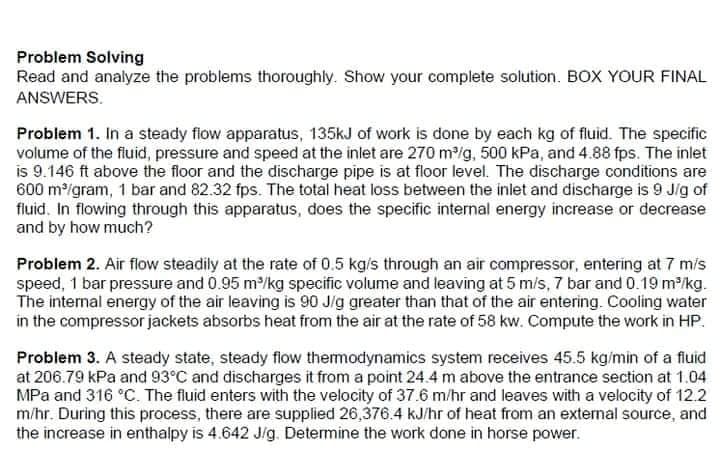Problem 1. In a steady flow apparatus, 135kJ of work is done by each kg of fluid. The specific volume of the fiuid, pressure and speed at the inlet are 270 mig, 500 kPa, and 4.88 fps. The inlet is 9.146 ft above the floor and the discharge pipe is at floor level. The discharge conditions are 600 m/gram, 1 bar and 82.32 fps. The total heat loss between the inlet and discharge is 9 Jig of fluid. In flowing through this apparatus, does the specific internal energy increase or decrease and by how much?
Problem 1. In a steady flow apparatus, 135kJ of work is done by each kg of fluid. The specific volume of the fiuid, pressure and speed at the inlet are 270 mig, 500 kPa, and 4.88 fps. The inlet is 9.146 ft above the floor and the discharge pipe is at floor level. The discharge conditions are 600 m/gram, 1 bar and 82.32 fps. The total heat loss between the inlet and discharge is 9 Jig of fluid. In flowing through this apparatus, does the specific internal energy increase or decrease and by how much?
Principles of Heat Transfer (Activate Learning with these NEW titles from Engineering!)
8th Edition
ISBN:9781305387102
Author:Kreith, Frank; Manglik, Raj M.
Publisher:Kreith, Frank; Manglik, Raj M.
Chapter6: Forced Convection Over Exterior Surfaces
Section: Chapter Questions
Problem 6.8P
Related questions
Question

Transcribed Image Text:Problem Solving
Read and analyze the problems thoroughly. Show your complete solution. BOX YOUR FINAL
ANSWERS.
Problem 1. In a steady flow apparatus, 135KJ of work is done by each kg of fluid. The specific
volume of the fluid, pressure and speed at the inlet are 270 m/g, 500 kPa, and 4.88 fps. The inlet
is 9.146 ft above the floor and the discharge pipe is at floor level. The discharge conditions are
600 m/gram, 1 bar and 82.32 fps. The total heat loss between the inlet and discharge is 9 Jig of
fluid. In flowing through this apparatus, does the specific internal energy increase or decrease
and by how much?
Problem 2. Air flow steadily at the rate of 0.5 kg/s through an air compressor, entering at 7 mis
speed, 1 bar pressure and 0.95 m/kg specific volume and leaving at 5 m/s, 7 bar and 0.19 m/kg.
The internal energy of the air leaving is 90 J/g greater than that of the air entering. Cooling water
in the compressor jackets absorbs heat from the air at the rate of 58 kw. Compute the work in HP.
Problem 3. A steady state, steady flow themodynamics system receives 45.5 kg/min of a fluid
at 206.79 kPa and 93°C and discharges it from a point 24.4 m above the entrance section at 1.04
MPa and 316 °C. The fluid enters with the velocity of 37.6 m/hr and leaves with a velocity of 12.2
m/hr. During this process, there are supplied 26,376.4 kJ/hr of heat from an external source, and
the increase in enthalpy is 4.642 Jig. Determine the work done in horse power.
Expert Solution
This question has been solved!
Explore an expertly crafted, step-by-step solution for a thorough understanding of key concepts.
Step by step
Solved in 2 steps with 2 images

Recommended textbooks for you

Principles of Heat Transfer (Activate Learning wi…
Mechanical Engineering
ISBN:
9781305387102
Author:
Kreith, Frank; Manglik, Raj M.
Publisher:
Cengage Learning

Principles of Heat Transfer (Activate Learning wi…
Mechanical Engineering
ISBN:
9781305387102
Author:
Kreith, Frank; Manglik, Raj M.
Publisher:
Cengage Learning